My last post was about hydrangeas–big, bold, and brazen. Well, this is a continuation on the same theme, as I’ve realized that hydrangeas also stick around longer than you’d expect. And come to think about it, they start early as well, keeping their buds tightly closed during late May and early June and opening in fits and starts as the rainy season
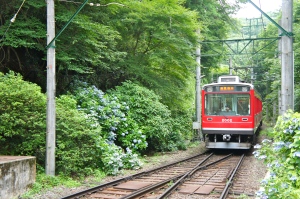
Here’s the mountain train to Gora station…and look! Hydrangeas still determinedly blooming in late July!
begins in earnest. And even in the tail end of July, the last of the dried-out blossoms stubbornly cling to life, unlike compliant sakura petals which are resigned to parting from the mother tree after only a few days of glory. Yes, sakura are much “prettier”, but how vulnerable their petals are to both wind and rain. Not so the hydrangea–no, not at all. Just last Wednesday I rode the Tozan Densha, or “Mountain Train” up to the mountains of Gora, and was astonished to see hydrangea, some retaining their colors and some brittle and beginning to decay, still blooming along the narrow train tracks. “Do them a favor and look at them kindly, with understanding, ” said the train conductor. “They’ve had a long, hard season.” I was impressed.
Likewise, I continue to be impressed with the tenacity and creativity of the crowds who show up weekly in the government district of Tokyo to raise their voices against the re-start of nuclear power plants. I’ve been attending demonstrations for a full year now, and am starting to appreciate the progress that’s been made as I experience it on a personal
level. Last year, for instance, I remember marching through the Harajuku district feeling out of sync with everything around me. Only a few people here and there shouting encouragement, and crowds of fashionably-dressed shoppers gawking at us weirdos with our sweaty faces and handmade placards. I swear there were more old people than young, and that bothered me terribly. I didn’t mind so much feeling “uncool”, but I wasn’t convinced that our efforts weren’t futile. Surely no “real” demonstration is complete and effective without a bunch of young people waving tambourines in the air, right? I was hoping for energy, excitement, and tension, but marching with the fifty-and-over-crowd, things were pretty tame. Mind you, I know my place: I’m not saying I wanted to be dancing along with the tambourine-shaking twenty-somethings, but I at least wanted to enjoy watching them in action.
Another troubling factor was the slow pace and tight crowd control. Even at rallies with tens of thousands present, the actual parade or march around town was always closely monitored by police, with sometimes an hour of waiting time before the line began to move, and only small groups allowed out on the street with staggered starts. Hard to feel either power or unity in such a situation, and I sometimes ended up in a very quiet group with no “call leader” to holler out the anti-nuke chants. Especially if no-one in the group was even carrying a

Pedestrians taking a stroll through the city? No, this is actually an anti-nuke parade. This past March, a huge crowd of energized citizens was reduced to a thin trickle of weary walkers. My daughter’s still energized, though…look, she’s levitating!
placard or wearing a shirt with an anti-nuke logo, it felt more like a well-organized field trip in the city. Needless to say, there was little or no press coverage of these first rallies; this made everything seem even stranger, as if I was not only out of sync with society, but perhaps not even living in reality. Thank goodness I have plenty of photos in my library to prove that these “field trips” actually existed.
But things have finally heated up! Since the sudden and loudly-protested re-start of the Ooi nuclear power plant in Fukui Prefecture, demonstrations have been held regularly in the government district every Friday evening. At first, the participants numbered in the hundreds. Then the thousands. Then the ten thousands. And now there’s no way of getting an accurate count, though organizers are stationed at all strategic points with counters, clicking away fast and furious, and helicopters hover overhead to get an ariel view of the crowds and how far back they extend. See those ariel photographs here, and take a minute to consider the time and manpower involved in crowd control, and the increasing frustration experienced by the Tokyo Metropolitan Police as they attempt to convince an increasingly unpredictable and ( I love this word) brazen army of citizens to do things “their way”.
In my Hydrangeas and Revolution post, I bewailed the fact that these regularly scheduled demos occur on Friday nights when I am committed to work, rather than on a more “convenient” day of the week. Well, school’s out for the summer (meaning I’m officially on vacation), and I’ve been gung-ho to get myself to Tokyo to be part of the the action. And wouldn’t you know? The first Friday I had free, word was that there was NO DEMO. So I stayed home. And, in fact, there WAS a demo after all (according to friends in the the know), because people simply showed up as usual, raring to go. And the “real demo” was held on Sunday as well. I made it to the Sunday event, and I’d like to write a bit about it.
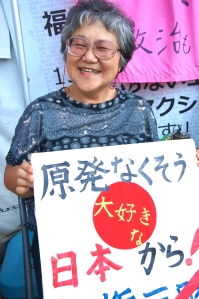
Obitani Reiko-san and her handmade flipboard poster…. Japanese characters painstakingly cut from colored duct tape!
I made the trip into Tokyo by myself, as usual, but with a tentative plan to meet up with Jacinta (of “Embrace Transitions”) at some point during the late afternoon. For the first time, I was dressed in an official No Nukes t-shirt (found on-line, simply by doing a search for “anti-nuke goods”) with a laminated placard attached to the back. Feeling pleased about this, I set out first for the tents in Kasumigaseki, where a group of supporters of Fukushima mothers have been camped out on the sidewalk since last summer. How were the guardians of the tent faring in the searing heat?? Very well, thank you! My friend Reiko-san was seated outside, putting the finishing touches on her story-panel demonstration poster for the march. Let me describe Reiko, since she’s fairly typical of the type of women who are the backbone of the anti-nuclear movement. She’s a decade older than me–a grandmother–and has twice my energy and gumption. Leaving her husband to fend for himself three days a week, she devotes that time to participating in rallies and guarding the tent; Wednesday nights, she sleeps in the tent, along with a core group of supporters that includes an eager beaver 23 year old male English conversation teacher! I have yet to meet the youngster in question, but Reiko assures me it is all in the interest of nuclear-free Japan ( she is, nonetheless, thrilled at the opportunity ). On this particular morning, she was up at 4:30 to make her husband’s breakfast and box lunch (annoying, but it must be done), after which she was free to work on her masterpiece: the flipboard poster with multiple messages, made from colored packing tape and two curtain rods with adjustable height. She showed me how the rods could be stuck into her fanny pack, requiring very little effort to keep the poster aloft. I am a big fan of this kind of small-scale innovation, and immediately resolved to get a bit more creative in my own efforts. Reiko doesn’t give a hoot what friends and family say about her excursions to Tokyo (she’s from Yokohama, and comes in by train, like me), and she spends the other four days of the week in her Yokohama home, fulfilling her duties as a proper grandma. If I were her grandchild, I’d be bragging about her to all my friends, left and right.
After exchanging greetings at the tents, I set off for Hibiya Koen, the site of the rally and starting point for the day’s parade. Which is to say, I followed the steady stream of people who were headed toward what sounded like a circus come to town. The small park space was jam-packed with Catholic nuns, Buddhist priests, assorted foreigners, young parents with babies-in-snugli, old guys with straw hats, cool guys with body paint, hippies with hairy chins, beauties with fashionable sunglasses, and more. I squeezed my way through the crowd, admiring the creativity and variety of signs and costumes, and getting as many photographs as possible.
There was the usual waiting time between the rally and the parade, while police worked to prevent hoards of protesters from swarming onto the street by allowing only a thin trickle of people onto the sidewalk at any given time and cordoning off the main part of the road with dragon’s teeth. When we moved out onto the street, however, the thin, snaking line of protesters kept up a constantly high level of energy that was matched by the cheers and encouragement of supporters on the sidelines–not marching, but there to support the marchers–and passengers in cars and taxis hollering “No Nukes!” from out open windows. Unlike last year or even this past spring, when I felt out of sync with the city, on this day I felt that we owned the city, and that was a great feeling.

I marched alongside this very vocal man in his dapper safari hat….until my eardrums began to ring. Can you see that the guy to the left is also clacking wooden blocks together?
As I marched (unaffiliated, so I could weave in and out among different groups), older Japanese men would often strike up conversations with me. “Look at this narrow space!” one man sputtered. “It’s not like this in American, is it? A protest is a protest, and that means the protesters are in charge! The protesters should take the whole street! Japanese people should be ashamed!” Even so, in the groups of marchers I moved with, no-one dared disobey the sullen-looking, humorless police officers whose sole job was to stand in the hot sun (wearing navy blue, no less) guarding the dragon’s teeth that “held back” the marchers. I cannot take credit for leading a revolt of any sort, but I did amuse myself by being a nuisance, slyly (I fancied) moving a dragon’s tooth toward the center of the road whenever an officer’s back was turned.
After the march, people milled around Hibiya Koen and began organizing to walk toward the diet building for the final event: a human chain around the central government area. A young man with googly glasses from “Aka Hata” , or the Japanese Communist Party, helped me up onto a large stone monument. From there I surveyed the crowd, searching for Jacinta and her godchild Tenko….and suddenly there they were: Jacinta in a sweet little tomato-red dress and long-legged Tenko in bright orange shorts with huge red cherries! I felt terribly under-dressed, but decided to act as if I weren’t (this generally works), and we all set off to be part of the human chain. From here on in the crowd steadily increased, as many people had not gotten to the rally and parade beforehand because of the heat, but were determined to make it to the chain.
Police were everywhere: along the sidewalks, directing movement at intersections, and looming above the crowds in cherry pickers, calling cheery instructions from megaphones. “There’s a big crowd here tonight, folks! No pushing and shoving now, and please move
along in an organized manner.” The cheery megaphone instructions added the strangest touch to the evening, making it seem as if the Tokyo Metropolitan Police were actually the hosts of the event, rather than enforcers of law and order. I got a shot of this genuinely nice-looking officer holding an animated conversation with an elderly protestor…you can’t fake smiles like that, and I’d bet he’s a good guy, inside and out. At any rate, a nice contrast to the dour-looking older officers guarding the dragons’ teeth during the march.
Continuing our walk toward the diet building, we passed by a group of women camped out on the sidewalk….and Jeffery Jousan, a mutual friend (also in tomato-red), who called out, “Come meet the Fukushima ladies!!” So we did. The ladies were clustered around a cheery-looking woman in a wheelchair, who waved to us to come on over. The woman had cerebral palsy, and was eager to give us a statement she had prepared in English entitled,
“We Stand Against Nuclear Power Plants that Kill People With Disabilities!” I took the paper, but before I had time to glance at it, another woman tapped me on the arm and began telling me her own story. Amid the chaos and constant movement on the sidewalk, I strained to listen as she told me of her home, 2 miles from the Fukushima Daiichi power plant, which has been abandoned and ransacked by thieves. “But how can I sit around and cry? ” she said, shaking her head vigorously. “Look at all the wonderful new friends I have! See how positive they are!” I wished her well, squeezed her hand, waved to the woman in the wheelchair, hugged Jeffrey, and set off on the route again, tagging along after the red tomato dress and red cherry shorts.
To follow up on the woman in the wheelchair, Masayo Furui, I have since read her profile online and learned that she is a mother, a writer, a speaker, and an activist on behalf of those with disabilities living in Japan. She was seated with the “Fukushima Ladies” not because she’s from Fukushima, but because she’s been active in a support center for disabled Fukushima residents that was established after the quake. The loss of an appallingly high number of elderly and disabled people who were unable to evacuate swiftly, left behind in the ensuing panic of the nuclear explosions, or suffered physical and mental trauma from the evacuation process itself is now well-known and deeply regretted; Furui wants to impart strength and courage to those who survived, and to teach them to live independently, with pride. Read her statement, and learn about the history of cerebral palsy victims in Japan (many of whom were aborted before birth, or murdered shortly after) and their struggle to attain the most basic of human rights.

Japanese are known for their promptness. These women have arrived early and claimed a nice comfortable spot in the human chain.
Shortly after meeting up with the “Ladies”, Jacinta, Tenko, and I found an open patch of sidewalk and linked up with the human chain, spending the next hour watching the procession of people. Bearing candles or penlights, still waving placards and chanting vigorously, capturing the moment with their iPhones, the line of citizens seemed unending. Those around us were in high spirits, showing no signs of the usual Japanese reserve with strangers. After 30 minutes of chanting and chatting together, the old guys on my right had to leave. They offered to take our picture, and I of course took theirs. “Get her email address, so we can exchange photos!” said one man urgently to his buddy. “Uh, how do I do that?” said the other, technically-challenged, grampa. “Seki-gaisen, you dummy!” said the friend. That’s “infrared communication” in English. And it’s not possible with the iPhone, so I did my best to rapidly type in his address, squinting away near-sightedly in the dim light. We exchanged photos by cellphone/iPhone later on, and I saw others around me doing the same: making friends and networking enthusiastically. It occurred to me afterwards that this is a new way of socializing for many Japanese, and I knew that the excitement of connecting with complete strangers (foreigners, even!) in support of a common cause would draw them back to the government district again.
And although I did not see it with my own eyes, there was a brief ten minute period of real chaos, with police on the run (that part I saw, but did not know where they were headed or why) and protesters breaking through barriers and rushing en masse into the street. A Dutch journalist captured the incident on video, providing English subtitles explaining the sequence of events. What is clear from the short clip is that two cameramen were thrown to the ground and a woman was roughly dragged by a plainclothes policeman; even so, both sides attempted to exercise restraint. There were no injuries, the incident ended peacefully, and on the dot of eight (the appointed closing time), protesters began returning home. Still moving in orderly lines, carrying their trash with them, and careful to make way for families with small children, citizens made their way back to the nearest train station, where restaurants overflowed with customers and conversation.
My daughter and I watched the six minute film together, and her eyes widened in surprise. “Oooh, look,” she gasped. “Japanese are disobeying orders! They’re ignoring the police! ” Now please know that everything is relative. The incident recorded in the film will seem tame to many folks outside of Japan, especially those who live in countries where police wouldn’t dream of attending a protest without riot gear and are quick to brandish their nightsticks (or worse), or those who live in countries where protesters are armed with stones and bricks (or worse). But to the average Japanese, this short clip is quite shocking. Here are people clearly taking the initiative–taking a risk–and making the Tokyo Metropolitan police officers run around like panicked hens in a henhouse. Kjeld Duits, the journalist who shot the video, makes the logical observation that if the street had been open to the protesters in the first place, the incident would never have occurred. Too many people forced into a claustrophobically small space? Something was bound to happen, and will certainly happen again if the district police do not change their rigid approach to a constantly changing set of circumstances. Tune in this Friday (I’m assuming that there IS another demo planned in the government district, since I haven’t heard otherwise) to see if they’ve learned their lesson.
Are things really changing?? Yesterday’s Asahi Shinbun editorial is the most hopeful assessment yet. Describing how average Japanese citizens have become disillusioned with the process of “indirect democracy” (people voicing their concerns through representatives, who bring those concerns to the central government) , the article details how citizens are experimenting with “direct democracy”, or going straight to the top to ensure that their
voices are heard. After one massive rally outside the parliament, Prime Minister Noda was asked what he thought of the demonstration going on outside. Hemming and hawing, all he could come up with was, “Well, that’s a big noise they’re making, isn’t it?” Those words quickly became infamous as everyone, including NHK nightly news reporters, chided Noda for mistaking the voice of his own people and deeming it “noise”. I love this quote from a 77 year old woman from Hyogo Prefecture, who declared to reporters, “Democracy is supposed to be politics based on people’s opinions. Politics that ignores people’s voices is nothing more than fascism.”
After the Prime Minister’s televised and widely-ridiculed faux pas, organizers of the Friday protests met with a group of Diet members including former Prime Minister Naoto Kan; they are pressing for a direct meeting with Noda-san, who is said to be “not reluctant” about the idea. Direct democracy in the making? We will see. Another sign of
progress is the strong showing of a “green candidate” in a recent election in Yamaguchi Prefecture, where a new nuclear power plant scheduled for construction is currently “on hold”. Although the election was lost to a bureaucrat who supports nuclear power, the victory was a surprisingly close call, especially given that his anti-nuclear opponent, Tetsunari Iida, jumped into the race at the last minute. Read about the “good fight” in today’s Japan Times. Oh, and Justin McCurry of the UK Guardian reports on the launching of Japan’s first Green Party this week. Hoping to be officially recognized in time for the next general elections, this group of activists and local politicians aims to emulate the green parties of Europe, and to put the environment as their first priority. Hear, hear! The sooner the better, I say!
Meanwhile, Tokyo demonstrations grow steadily larger, and the mood is one of ever-increasing confidence, as even cynics cannot deny that progress is being made, albeit little by little. The Oi nuclear reactors have been re-started, but the government’s campaign to convince citizens of the “need” to re-start more power plants has been a dismal failure. While politicians focus on potential energy shortages in the immediate future, it is already August and despite heat and humidity that would test the patience of a saint, and some inevitable deaths from heat stroke (little old ladies found in stifling apartments with the windows closed), people are doing fine. After all, this is not a country where folks sit around all day running the air conditioner, eating bon-bons and painting their toenails. It’s a country where old people pull on their lederhosen (really!) and set off hiking , even in the hottest summer months; where women walk or bicycle to the local supermarket daily, regardless of hills or heat; and where children do not beg to be driven, but race off to the local pool on their bikes or scooters to spend the day tearing around in the hot sun. This is a tough country, where people work hard, play hard, and don’t whine about their troubles.
Temperatures soaring up into the 90s? That’s no excuse to cancel a street demonstration either, and Sunday’s parade was–as always–heavily populated by old folks. Wearing sensible shoes, sensible sun hats and sweat towels, and carrying fans and thermoses full of cold tea, they chanted, “Denki ga tariteru!” ( “We have enough electricity!”) Young folks joined them, brandishing signs reading, “Nuclear power? No, thank you. We have plenty of other alternatives.” Parents had their babies out on display, toddlers carried their own signs, free spirit types danced rather than marched, wheelchair protesters rolled along with the walkers, and middle-aged men blew bubbles from the sidelines.
Clearly, protesting is not just for hardened union members anymore. It’s a family outing! It’s fashionable! It’s a social event! …..and it’s desperately important for those from Fukushima who still seek justice and a measure of closure after losing the security of family, community, and the land they were meant to inherit. Those outside of Fukushima hold their breath and pray that they do not lose their health as well, as we all struggle to understand and come to terms with the reality of internal radiation exposure. And that’s the situation in a nutshell: a Tokyo demonstration is essentially a big old street party with deadly serious intent, buoyed by conviction born of disillusionment and betrayal. If you come to the party, you’d better be ready to play hard. Enjoy the photos, and marvel at the variety of people who came out to play in the heat.

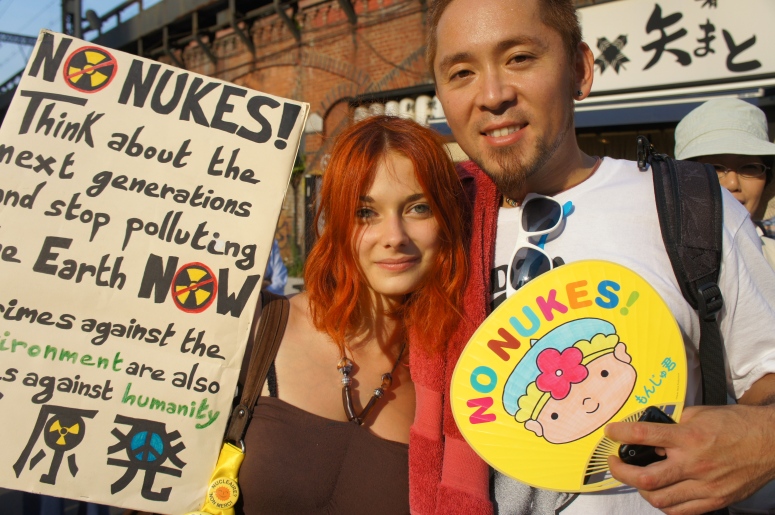




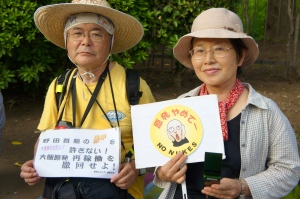
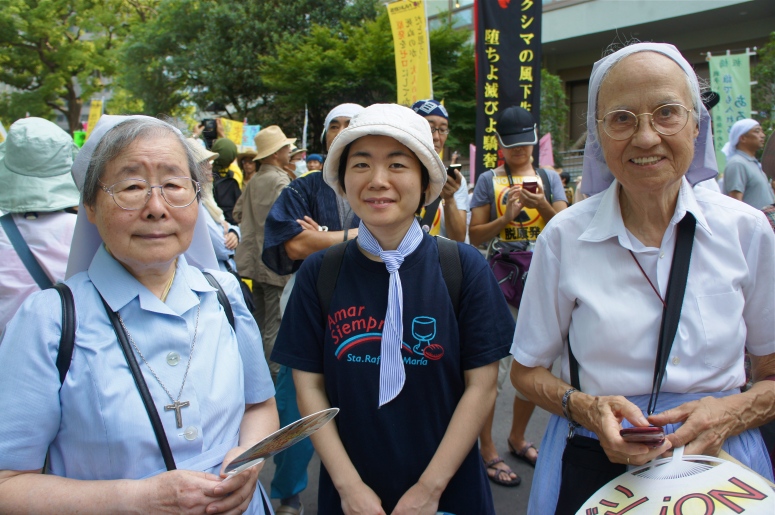
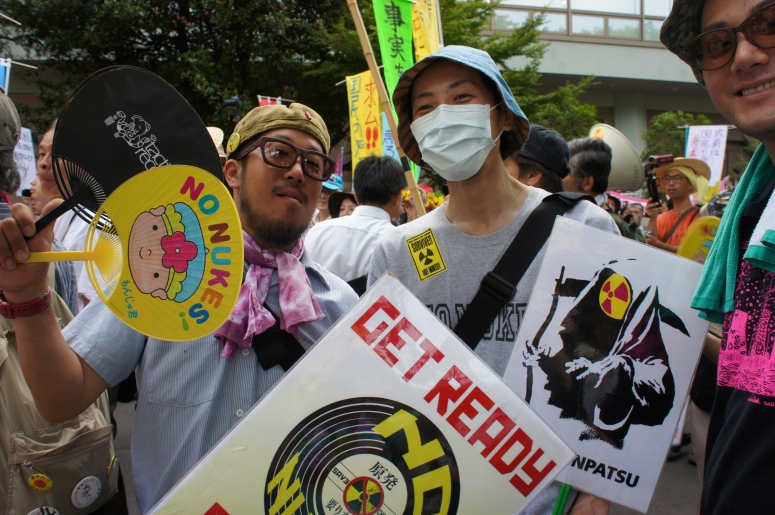



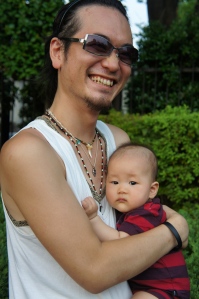

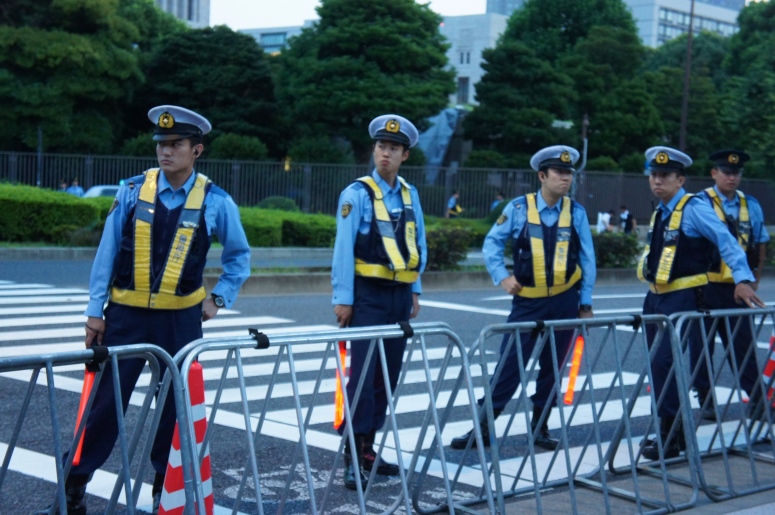
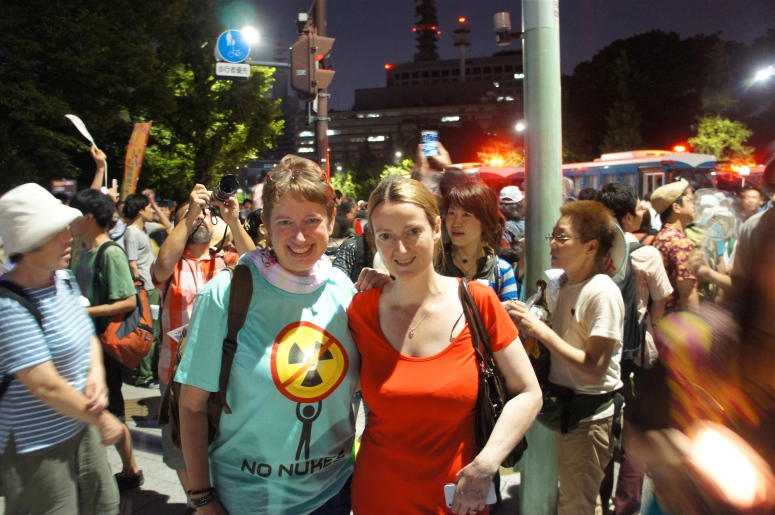

This is amazing. Thank you for sharing. I don’t watch the news in America or really for the rest of the world. I’ll watch NHK or read goo.com news sometimes. But I feel it only muddles one’s clarity of thought. I love that this was a direct source and you really get to see the emotion and feelings of the people. So glad I found your blog, I think we would get along just grand. You’ve accomplished much of what I’d like to. Maybe i should provide my real writing style on my blog instead of just nonsense, I might have more to offer people.
MM: I enjoyed your blog immensely, and no comments on what you “should” do with it. Thank you so much for reading mine; as you say, this is my “real” writing style, and I’m happy that what I had to say had an impact. Are you still in Japan, or learning the language abroad? If you’re here, you must come to the Friday night gatherings!
Reblogged this on PhillyHalfFull and commented:
We break from our usual broadcasting to bring you this important message. I will almost never bring do this. However, I feel the impact and importance of this piece is well worth sharing. This is significant not only on a Japanese level but on a human level. More than just an issue of Nuclear Power, which effects all of us, this is an expression of the emotional energy that fuels human beliefs. I’d Like to thank Kanagawa notebook for sharing this and I hope you support her amazing and insightful work.
Sincerely,
The author
Those outside Japan have no idea how amazing this grassroots action is proving to be, growing every week and forcing the mainstream to take notice. Great work Ruthie.